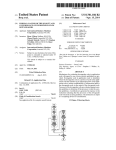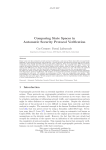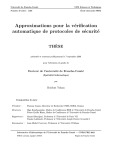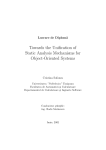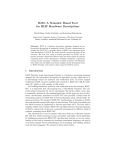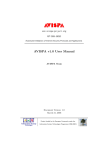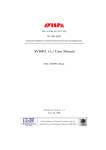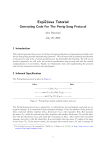Download HLPSL Tutorial - The AVISPA Project
Transcript
www.avispa-project.org
IST-2001-39252
Automated Validation of Internet Security Protocols and Applications
HLPSL Tutorial
A Beginner’s Guide
to
Modelling and Analysing Internet Security Protocols
The AVISPA team
Document Version: 1.1
June 30, 2006
Project funded by the European Community under the
Information Society Technologies Programme (1998-2002)
CONTENTS
1
Contents
1 HLPSL Basics
3
1.1
Using the AVISPA Tool . . . . . . . . . . . . . . . . . . . . . . . . . . . . . . . .
3
1.2
Basic Roles . . . . . . . . . . . . . . . . . . . . . . . . . . . . . . . . . . . . . . .
5
1.3
Transitions . . . . . . . . . . . . . . . . . . . . . . . . . . . . . . . . . . . . . . . .
6
1.4
Composed Roles . . . . . . . . . . . . . . . . . . . . . . . . . . . . . . . . . . . . .
7
2 HLPSL Examples
9
2.1
Example 1 - from Alice-Bob notation to HLPSL specification . . . . . . . . . . . .
9
2.2
Example 2 - common errors, untrusted agents, attack traces . . . . . . . . . . . .
14
2.2.1
Modelling Tips and Pitfalls . . . . . . . . . . . . . . . . . . . . . . . . . .
18
2.2.2
Discussion and Analysis Results . . . . . . . . . . . . . . . . . . . . . . . .
22
Example 3 - security goals . . . . . . . . . . . . . . . . . . . . . . . . . . . . . . .
25
2.3.1
Discussion and Analysis Results . . . . . . . . . . . . . . . . . . . . . . . .
28
Example 4 - Algebraic Operators . . . . . . . . . . . . . . . . . . . . . . . . . . .
34
2.3
2.4
3 HLPSL Tips
41
3.1
Priming Variables . . . . . . . . . . . . . . . . . . . . . . . . . . . . . . . . . . . .
41
3.2
Witness and Request . . . . . . . . . . . . . . . . . . . . . . . . . . . . . . . . . .
41
3.3
Secrecy . . . . . . . . . . . . . . . . . . . . . . . . . . . . . . . . . . . . . . . . . .
42
3.4
Constants and Variables . . . . . . . . . . . . . . . . . . . . . . . . . . . . . . . .
42
3.5
Concatenation (.) and Commas (,) . . . . . . . . . . . . . . . . . . . . . . . . . .
43
3.6
Exploring executability of your model . . . . . . . . . . . . . . . . . . . . . . . . .
43
3.7
Detecting Replay Attacks . . . . . . . . . . . . . . . . . . . . . . . . . . . . . . .
44
3.8
Instantiating Sessions . . . . . . . . . . . . . . . . . . . . . . . . . . . . . . . . . .
44
3.9
Function Results . . . . . . . . . . . . . . . . . . . . . . . . . . . . . . . . . . . .
47
3.10 Declaring Channels . . . . . . . . . . . . . . . . . . . . . . . . . . . . . . . . . . .
47
4 Questions and answers about HLPSL
48
A Symbols and Keywords
49
AVISPA
HLPSL Tutorial
CONTENTS
2
Introduction
The AVISPA Tool provides a suite of applications for building and analysing formal models of
security protocols. Protocol models are written in the High Level Protocol Specification Language,
or HLPSL [3, 9]. The aim of this tutorial is to provide some advice on constructing protocol models
in HLPSL.
In addition to this tutorial, the AVISPA Package User Manual [5] is another useful resource
for beginners to HLPSL. Please refer to this manual if you require further information on HLPSL
or any of the tools discussed throughout this tutorial.
Organisation of this tutorial: Section 1 contains a very basic introduction to what HLPSL looks
like and how it is used.
Section 2 contains four introductory examples that illustrate modelling with HLPSL. In discussing the examples, we attempt to show both correct solutions and possible pitfalls that modellers should be aware of.
Section 3 contains a number of tips useful for writing or reading HLPSL specifications.
Finally, Section 4 provides a list of questions and answers about HLPSL,
followed by an appendix containing a list of HLPSL keywords and symbols.
AVISPA
HLPSL Tutorial
3
1
HLPSL Basics
AVISPA provides a language called the High Level Protocol Specification Language (HLPSL) [3, 9]
for describing security protocols and specifying their intended security properties, as well as a set
of tools to formally validate them.
1.1
Using the AVISPA Tool
High−Level Protocol Specification Language (HLPSL)
Translator
HLPSL2IF
Intermediate Format (IF)
On−the−fly
Model−Checker
OFMC
CL−based
Attack Searcher
CL−AtSe
SAT−based
Model−Checker
SATMC
Tree Automata−based
Protocol Analyser
TA4SP
Output
Figure 1: Architecture of the AVISPA Tool
The structure of the AVISPA Tool [2] is shown in Fig. 1. A HLPSL specification is translated into the Intermediate Format (IF), using a translator called hlpsl2if. IF is a lower-level
language than HLPSL and is read directly by the back-ends to the AVISPA Tool. Note that
this intermediate translation step is transparent to the user, as the translator is called automatically. The interested reader can find more about the IF in the AVISPA User Manual and in the
AVISPA deliverable which discusses IF [4, 5]. The IF specification of a protocol is then input to
the back-ends of the AVISPA Tool to analyse if the security goals are satisfied or violated.
At the time of this writing, the AVISPA Tool comprises four back-ends: OFMC [6], CLAtSe [16], SATMC [1], and TA4SP[7]; this list may later be extended with new back-ends. The
Intermediate Format IF is designed with the objective that it should be simple for developers of
other analysis tools to use IF as their input language. Because the analysis methods of the four
AVISPA
HLPSL Tutorial
1.1 Using the AVISPA Tool
4
current back-ends are complementary (at least partially, in the sense that some basic techniques
are common to some of the back-ends) and not equivalent, situations might arise in which the
back-ends return different results.
Downloading and Running The AVISPA Tool The AVISPA Tool, as well as a very helpful XEmacs
mode for editing HLPSL specifications with syntax highlighting etc., and tools for documenting
HLPSL specifications in LATEXand HTML format, is available for download at http://www.
avispa-project.org/download.html. See the INSTALL and README files contained in the
package for further information.
There is also a web interface available at http://www.avispa-project.org/web-interface/
which allows users to experiment with HLPSL and the AVISPA Tool without having to install
anything. Through the web interface, you can select one of the protocols of the AVISPA library,
modify it if you like, or write a protocol on your own; you can use one of the four back-ends to
check the given protocol, or even use all of them and then compare their outputs.
If a security goal of the specification is violated, the back-ends provide a trace which shows
the sequence of events leading up to the violation and displays which goal was violated. The
command-line AVISPA Tool outputs attack traces in a textual form we will see later. The web
interface can also display an attack trace in the form of a Message Sequence Chart.
The AVISPA tool is called simply avispa. The -h flag returns usage information as follows:
% avispa -h
Given an HLPSL file called, for instance, example.hlpsl, we can invoke the AVISPA tool
with its default options as shown here:
% avispa example.hlpsl
By default, the AVISPA Tool invokes the OFMC back-end, also called a sub-module of the tool.
An alternative sub-module can be specified on the command-line in order to invoke a different
back-end. At the time of writing, the four valid sub-module arguments, corresponding to the
four back-ends listed above, are --ofmc, --satmc, --cl-atse and --ta4sp. For instance, we can
analyse the HLPSL file using SATMC as follows:
% avispa example.hlpsl --satmc
In this tutorial, we will focus on invoking the AVISPA Tool with the default options. The
usage information, which is printed when invoking avispa -h, gives a more complete description
of the options not discussed here.
We now discuss the HLPSL language itself.
AVISPA
HLPSL Tutorial
1.2 Basic Roles
1.2
5
Basic Roles
It is easiest to translate a protocol into HLPSL if it is first written in Alice-Bob (A-B) notation.
For example, below we illustrate A-B notation with the well-known Wide Mouth Frog protocol [8]:
A -> S : {Kab}_Kas
S -> B : {Kab}_Kbs
This simple protocol illustrates A-B notation as well as some of the naming conventions we
adopt throughout this document (and in general). In this protocol, A wishes to set up a secure
session with B by exchanging a new shared session key with the help of a trusted server S with
which A and B each share a key. We denote with Kas (respectively Kbs) the key shared between A
(respectively B) and S. A starts by generating a new session key, Kab, which is intended for B. She
encrypts this key with Kas and sends it to S in the first message (note that encryption is denoted
using curly brackets and the encryption key is identified following an _). S, in turn, decrypts the
message, re-encrypts Kab with Kbs, and sends the result on to B. After this exchange, A and B
share the new session key and can use it to communicate with one another.
A-B notation is convenient, as it gives us a clear illustration of the messages exchanged in a
normal run of a given protocol. Several protocol specification languages, including an older version
of HLPSL, are based on A-B notation. In practise, however, A-B notation is not expressive enough
to capture the sequence of events that need to be specified when considering large-scale Internet
protocols. For instance, such protocols often call for control-flow constructs such as if-then-else
branches, looping and other features. A-B notation, which shows only message exchanges, is
too high level to capture such constructs, which talk about the execution of actions by a single
participant of a protocol run. That’s why we need a more expressive language like HLPSL.
HLPSL is a role-based language, meaning that we specify the actions of each kind of participant
in a module, which is called a basic role. Later we instantiate these roles and we specify how the
resulting participants interact with one another by “gluing” multiple basic roles together into a
composed role. When modelling a protocol, it can be helpful to begin with an illustration of the
flow of messages in A-B notation, and then proceed with the specification of the basic roles. For
each (type of) participant in a protocol, there will be one basic role specifying his sequence of
actions. This specification can later be instantiated by one or more agents playing the given role.
In the case of the WMF protocol, for instance, there are three basic roles, which we call alice,
bob, and server. We note that role names always begin with lower-case letters. We use, for
instance, the name alice to denote the role itself, while the name of the agent playing the role
will be called A, as in the A-B notation above.
Each basic role describes what information the participant can use initially (parameters), its
initial state, and ways in which the state can change (transitions). For instance, the role of alice
in the protocol above might look like this:
AVISPA
HLPSL Tutorial
1.3 Transitions
6
role alice(A,B,S : agent,
Kas : symmetric_key,
SND, RCV : channel (dy))
played_by A def=
local State: nat, Kab: symmetric_key
init State := 0
transition
...
end role
This is (a fragment of) a role known as alice, with parameters A, B and S of type agent, and
Kas of type symmetric_key. The RCV and SND parameters are of type channel, indicating that
these are channels upon which the agent playing role alice will communicate. The attribute to
the channel type, in this case (dy), denotes the intruder model to be considered for this channel.
Intruder models are discussed further below.
All variables in HLPSL begin with a capital letter, and all constants begin with a lower-case
letter. Moreover, all variables and constants are typed. For the moment, assume that these
parameter values are passed to role alice from elsewhere. The parameter A appears in the
played_by section, which means, intuitively, that A denotes the name of the agent who plays role
alice. Also note the local section which declares local variables of alice: in this case, one
called State which is a nat (a natural number) and another called Kab, which will represent the
new session key. The local State variable is initialised to 0 in the init section.
For information about the different types available in HLPSL and other details, please see the
AVISPA User Manual [5].
1.3
Transitions
The transition section of a HLPSL specification contains a set of transitions. Generally, each
one represents the receipt of a message and the sending of a reply message. A transition consists
of a trigger, or precondition, and an action to be performed when the trigger event occurs. An
example belonging to role server of our running example is shown here:
step1. State = 0 /\ RCV({Kab’}_Kas) =|>
State’:= 2 /\ SND({Kab’}_Kbs)
This is a transition called step1, though the names of the transitions serve merely to distinguish them from one another. It specifies that if the value of State is equal to zero and a message
is received on channel RCV which contains some value Kab’ encrypted with Kas, then a transition
fires which sets the new value of State to 2 and sends the same value Kab’ on channel SND, but
this time encrypted with Kbs.
AVISPA
HLPSL Tutorial
1.4 Composed Roles
7
Here we see an example of priming: X’ means the new value of the variable X. We say “X
prime” (the notation stems from the temporal logic TLA [12, 13], upon which HLPSL is based).
It is important to realise that the value of the variable will not be changed until the current
transition is complete. So, the right-hand-side tells us that the value of the State variable, after
transition step1 fires, will be 2.
A more interesting example, however, is the primed variable that is within the RCV. In this
case, we bind the variable to whatever is received. As in the example, we can specify a structure
of the message that is expected: in this case, we expect an encrypted message. The message
must be encrypted with key Kas: the fact that this variable is not primed indicates that the
received message must have the same value as the current value of the variable. The contents of
the encrypted message, however, can be arbitrary. Whatever is in there, it will be bound to the
variable Kab in the next step, because it is primed.
This is how one may model the way in which the information available to a role may change.
1.4
Composed Roles
Composed roles instantiate one or more basic roles, “gluing” them together so they execute
together, usually in parallel (with interleaving semantics). Once you have defined your basic
roles, you need to define composed roles which describe sessions of the protocol. If we assume,
in addition to the alice role we’ve already discussed, that we also have a bob and a server role
with the arguments one would expect, then we can define a composed role which instantiates
one instance of each basic role and thus describes one whole protocol session. By convention, we
generally call such a composed role session.
role session(A,B,S
: agent,
Kas, Kbs : symmetric_key) def=
local SA, RA, SB, RB SS, RS: channel (dy)
composition
alice (A, B, S, Kas, SA, RA)
/\ bob
(B, A, S, Kbs, SB, RB)
/\ server(S, A, B, Kas, Kbs, SS, RS)
end role
Composed roles have no transition section, but rather a composition section in which the
basic roles are instantiated. The /\ operator indicates that these roles should execute in parallel.
In the session role, one usually declares all the channels used by the basic roles. These
variables are not instantiated with concrete constants. The channel type takes an additional
AVISPA
HLPSL Tutorial
1.4 Composed Roles
8
attribute, in parentheses, which specifies the intruder model one assumes for that channel. Here,
the type declaration channel (dy) stands for the Dolev-Yao intruder model [11]. Under this
model, the intruder has full control over the network, such that all messages sent by agents will
go to the intruder. He may intercept, analyse, and/or modify messages (as far as he knows the
required keys), and send any message he composes to whoever he pleases, posing as any other
agent. As a consequence, the agents can send and receive on whichever channel they want; the
intended connection between certain channel variables (e.g. alice sends on SA some messages to
bob who receives them on RB) is irrelevant because the intruder is the network.
Finally, a top-level role is always defined. This role contains global constants and a composition
of one or more sessions, where the intruder may play some roles as a legitimate user. There is also
a statement which describes what knowledge the intruder initially has. Typically, this includes
the names of all agents, all public keys, his own private key, any keys he shares with others,
and all publicly known functions. Note that the constant i is used to refer to the intruder. For
example:
role environment()
def=
const a, b, s
: agent,
kas, kbs, kis : symmetric_key
intruder_knowledge = {a, b, s, kis}
composition
session(a,b,s,kas,kbs)
/\ session(a,i,s,kas,kis)
/\ session(i,b,s,kis,kbs)
end role
The final statement in a specification is always an instantiation of the top level role:
environment()
This section has given a basic understanding of the structure of HLPSL specifications. Readers new to HLPSL are recommended to continue reading to the next section of this tutorial.
More detailed information on HLPSL specifications can be found in the AVISPA Package User
Manual [5], which describes the full syntax and semantics of HLPSL.
AVISPA
HLPSL Tutorial
9
2
HLPSL Examples
2.1
Example 1 - from Alice-Bob notation to HLPSL specification
Suppose A and B share a secret key K (i.e. K is a value known only to A and B). Consider the
following protocol for producing a new shared key K1:
A -> B: {Na}_K
B -> A: {Nb}_K
A -> B: {Nb}_K1, where K1=Hash(Na.Nb)
In Alice-Bob notation, this reads: A sends to B a nonce Na, encrypted with K. B then sends to
A another nonce Nb also encrypted with K. Finally A calculates a new key K1 by hashing the value
of Na and Nb concatenated together, and sends back to B the value of Nb encrypted with K1.
Goals of the Example Protocol We will discuss the concrete modelling of security goals in a coming
example, but we summarise the intended security goals of this example protocol here. This is a
(toy) key exchange protocol in which the first two messages serve to establish key agreement, and
the last one serves as proof that A has the new key. Our first goal for this example is unilateral
authentication: that is, that B authenticates A on Nb (on the last message), in other words: when
B receives the third message, he can be sure that Nb was sent by A. Furthermore, we require strong
authentication, an extension of so-called weak authentication which precludes replay attacks. We
can thus also conclude that, if strong authentication is achieved, then Nb has not been previously
received by B. As a second security goal, the new key K1 should be kept secret.
Below is a fragment of role alice modelled in HLPSL. Note that comments in a HLPSL
specification begin with the % symbol and continue to the end of the line.
role alice(..,
K: symmetric_key,
Hash: hash_func,
..)
... def=
local
...
State : nat
% K and Hash must be passed to each
% role, so that A and B agree on them.
% This variable is typically defined in all roles.
init
State := 1
AVISPA
HLPSL Tutorial
2.1 Example 1 - from Alice-Bob notation to HLPSL specification
10
transition
1. State = 1 /\ RCV(start) =|>
State’:= 2 /\ Na’ := new() /\ SND({Na’}_K)
2. State = 2 /\ RCV({Nb’}_K) =|>
State’:= 3 /\ SND({Nb’}_Hash(Na.Nb’))
Discussion: Modelling Shared Knowledge Recall that A and B are assumed to agree beforehand
on the value of K. They must also agree on which cryptographic hash function they will use in
order to generate K1. We model such pre-shared knowledge by passing the same values to those
instances of roles alice and bob who should participate in a session together.1 These values
are passed from the calling composition role, as can be seen in the full example below: the first
session between a and b uses key kab for the value of K, while the second between a and the
intruder i uses kai. (Recall that lower case identifiers denote constants.) All three sessions use
the same hash function h. Although the variable names in the sharing roles need not necessarily
be the same, by convention one generally gives them the same names.
Discussion: Transitions The first transition is relatively clear, but it illustrates an important
feature of HLPSL: namely, how one models the generation of fresh data. start is a signal for
alice to begin the protocol run. She creates a fresh value for nonce Na by assigning it to new(),
which intuitively means that value is generated randomly.2 We note also that new() can be
applied to data of arbitrary types, for instance to generate fresh values of type symmetric_key.
She encrypts this value using key K before inserting the encrypted value into the channel called
SND. After this transition, alice is in state 2.
The second transition is trickier. Firstly, alice receives a message {Nb’}_K. Provided that
alice is in state 2 and that this message is of the form {*}_K, for some value *, alice sets Nb
to be the received value encrypted under K. In the same transition, the newly received value is
stored as the new value of Nb and sent out again, encrypted with the key Hash(Na.Nb’) which is
computed by hashing the concatenation of the two values Na and Nb’.
The full solution for this example is provided below. Note that it contains a number of
aspects yet to be explained. For example, this specification contains the terms secret, witness
and request (all of which are related to describing security goals). As these concepts will be
covered later in the tutorial, it is safe to ignore them for now.
1
Note that the value of K known by two instances of alice who participate in different sessions can, of course,
be different.
2
More precisely, each freshly generated value is unique and has never been generated before.
AVISPA
HLPSL Tutorial
2.1 Example 1 - from Alice-Bob notation to HLPSL specification
11
Example 1:
——————————————————————————————————————————
role alice(
A,B
: agent,
K
: symmetric_key,
Hash
: hash_func,
SND,RCV : channel(dy))
played_by A def=
local
State
Na,Nb
K1
: nat,
: text,
: message
init
State := 0
transition
1. State = 0 /\ RCV(start) =|>
State’:= 2 /\ Na’ := new()
/\ SND({Na’}_K)
2. State = 2 /\
State’:= 4 /\
/\
/\
RCV({Nb’}_K) =|>
K1’ := Hash(Na.Nb’)
SND({Nb’}_K1’)
witness(A,B,bob_alice_nb,Nb’)
end role
——————————————————————————————————————————
role bob(
A,B
K
Hash
SND,RCV
played_by B
: agent,
: symmetric_key,
: hash_func,
: channel(dy))
def=
local
AVISPA
HLPSL Tutorial
2.1 Example 1 - from Alice-Bob notation to HLPSL specification
State
Nb,Na
K1
12
: nat,
: text,
: message
init
State := 1
transition
1. State = 1 /\
State’:= 3 /\
/\
/\
/\
RCV({Na’}_K) =|>
Nb’ := new()
SND({Nb’}_K)
K1’:= Hash(Na’.Nb’)
secret(K1’,k1,{A,B})
2. State = 3 /\ RCV({Nb}_K1) =|>
State’:= 5 /\ request(B,A,bob_alice_nb,Nb)
end role
——————————————————————————————————————————
role session(
A,B : agent,
K
: symmetric_key,
Hash : hash_func)
def=
local SA, SB, RA, RB : channel (dy)
composition
alice(A,B,K,Hash,SA,RA)
/\ bob (A,B,K,Hash,SB,RB)
end role
——————————————————————————————————————————
role environment()
def=
AVISPA
HLPSL Tutorial
2.1 Example 1 - from Alice-Bob notation to HLPSL specification
const
bob_alice_nb,
k1
:
kab,kai,kib :
a,b
:
h
:
13
protocol_id,
symmetric_key,
agent,
hash_func
intruder_knowledge = {a,b,h,kai,kib}
composition
session(a,b,kab,h)
/\ session(a,i,kai,h)
/\ session(i,b,kib,h)
end role
——————————————————————————————————————————
goal
secrecy_of k1
authentication_on bob_alice_nb
end goal
——————————————————————————————————————————
environment()
——————————————————————————————————————————
Running the AVISPA Tool on this example returns the following output:
% avispa ex1.hlpsl
% OFMC
% Version of 2005/06/07
SUMMARY
SAFE
DETAILS
BOUNDED_NUMBER_OF_SESSIONS
AVISPA
HLPSL Tutorial
2.2 Example 2 - common errors, untrusted agents, attack traces
14
PROTOCOL
./ex1.if
GOAL
as_specified
BACKEND
OFMC
COMMENTS
STATISTICS
parseTime: 0.00s
searchTime: 0.16s
visitedNodes: 105 nodes
depth: 8 plies
As we remarked above, the tool calls the OFMC back-end when called with the default options.
We can see that OFMC found no attacks. In other words, the stated security goals were satisfied
for a bounded number of sessions as specified in environment role. The AVISPA Tool supports
alternatives to a bounded scenario (that is, a bounded number of concrete sessions), but these go
beyond the scope of this tutorial. We refer the interested reader to the AVISPA User Manual [5].
2.2
Example 2 - common errors, untrusted agents, attack traces
This example considers a Kerberos-style protocol with 3 principals: A, B and S. A wishes to
establish a secret key K with B, but both have only secret keys with S. A asks S for such a key,
giving his identity and the identity of B. Figure 2 provides a graphical representation of this
protocol.
Alice-Bob Notation:
A -> S: (A.B.{Na}_Ka)
A <- S: (A.B.{K.Na.Ns}_Ka.
{K.Na.Ns}_Kb)
A -> B: (A.B.{K.Na.Ns}_Kb.
{Na.Ns}_K)
%
%
%
%
Ka is a key shared by A and S
S generates new key K
A cannot decrypt the contents of {K.Na.Ns}_Kb
but he is able to forward that to B
% The last part is
% a key confirmation: B knows K
A <- B: (A.B.{Ns.Na}_K)
We give a full HLPSL specification of this protocol below and then discuss the protocol model
and a number pitfalls that HLPSL modellers should be aware of.
——————————————————————————————————————————
role alice (A, S, B: agent,
AVISPA
HLPSL Tutorial
2.2 Example 2 - common errors, untrusted agents, attack traces
15
S
A requests S to
generate a shared
key to be used
with B.
1
S returns two encrypted copies of the shared key:
one encrypted with A’s secret key and another
encrypted with B’s secret key.
2
A
A forwards the shared key encrypted
with B’s secret key.
3
B acknowledges receipt
of the shared key.
B
4
Figure 2: Representation of the Kerberos-style protocol of Example 2
Ka
: symmetric_key,
SND_SA, RCV_SA, SND_BA, RCV_BA: channel(dy))
played_by A
def=
local State
Na,Ns
K
X
init
:
:
:
:
nat,
text,
symmetric_key,
{symmetric_key.text.text}_symmetric_key
State := 0
transition
1. State = 0 /\ RCV_BA(start) =|>
State’:= 2 /\ Na’ := new()
/\ SND_SA(A.B.{Na’}_Ka)
2. State
AVISPA
= 2 /\ RCV_SA(A.B.{K’.Na.Ns’}_Ka.X’) =|>
HLPSL Tutorial
2.2 Example 2 - common errors, untrusted agents, attack traces
16
State’:= 4 /\ SND_BA(A.B.X’.{Na.Ns’}_K’)
3. State = 4 /\ RCV_BA(A.B.{Ns.Na}_K) =|>
State’:= 6 /\ request(A,B,alice_bob_na,Na)
end role
——————————————————————————————————————————
role server (A, S, B : agent,
Ka, Kb
: symmetric_key,
SND_AS, RCV_AS: channel(dy))
played_by S
def=
local State : nat,
Ns,Na : text,
K
: symmetric_key
init
State := 1
transition
1. State = 1 /\
State’:= 3 /\
/\
/\
RCV_AS(A.B.{Na’}_Ka) =|>
Ns’ := new() /\ K’ := new()
SND_AS(A.B.{K’.Na’.Ns’}_Ka.{K’.Na’.Ns’}_Kb)
secret(K’,k,{A,B,S})
end role
——————————————————————————————————————————
role bob (A, S, B: agent,
Kb
: symmetric_key,
SND_AB, RCV_AB: channel(dy))
played_by B
def=
local State
Ns, Na
K
AVISPA
: nat,
: text,
: symmetric_key
HLPSL Tutorial
2.2 Example 2 - common errors, untrusted agents, attack traces
init
17
State := 5
transition
1. State = 5 /\ RCV_AB(A.B.{K’.Na’.Ns’}_Kb.{Na’.Ns’}_K’) =|>
State’:= 7 /\ SND_AB(A.B.{Ns’.Na’}_K’)
/\ witness(B,A,alice_bob_na,Na’)
end role
——————————————————————————————————————————
role session(A, S, B
Ka, Kb
def=
local
SSA,
SBA,
SAS,
SAB,
: agent,
: symmetric_key)
RSA,
RBA,
RAS,
RAB : channel (dy)
composition
/\
/\
alice (A, S, B, Ka, SSA, RSA, SBA, RBA)
server(A, S, B, Ka, Kb, SAS, RAS)
bob
(A, S, B, Kb, SAB, RAB)
end role
——————————————————————————————————————————
role environment()
def=
const a, b, s
: agent,
ka, kb, ki
: symmetric_key,
alice_bob_na, k: protocol_id
intruder_knowledge = {a, b, s, ki}
AVISPA
HLPSL Tutorial
2.2 Example 2 - common errors, untrusted agents, attack traces
18
composition
session(a,s,b,ka,kb)
/\ session(a,s,i,ka,ki)
/\ session(i,s,b,ki,kb)
end role
——————————————————————————————————————————
goal
secrecy_of k
authentication_on alice_bob_na
end goal
——————————————————————————————————————————
environment()
——————————————————————————————————————————
2.2.1
Modelling Tips and Pitfalls
Priming Placing primes correctly can be difficult but is very important for the correctness of
protocol models. Consider, for instance, the first transition of role bob. One could potentially
make the simple omission of forgetting one or more of the primes on variable Na, yielding the
following transition:
1. State = 5 /\ RCV_AB(A.B.{K’.Na.Ns’}_Kb.{Na.Ns’}_K’) =|>
State’:= 7 /\ SND_AB(A.B.{Ns’.Na}_K’)
/\ witness(B,A,alice_bob_na,Na)
This simple error renders the transition non-executable. The reason is that an unprimed
variable within a receive action serves to restrict the messages that will be accepted: in this case,
for example, the role bob expects to be talking to a certain agent A, and should accept only
messages where this value of A appears in the first part of the message he receives. Therefore, the
variable A is written without a prime, indicating that the current value of A, which in this case
is a parameter of role, is used as a pattern. Yet failing to give the prime for variable Na has the
AVISPA
HLPSL Tutorial
2.2 Example 2 - common errors, untrusted agents, attack traces
19
effect of erroneously restricting the accepted messages to those having at the given position the
current value of Na. Even worse, this value is undefined since Na has not been initialized! Since
no messages satisfy this requirement, the transition can never fire. Correcting this using a prime,
i.e. Na’, we get the desired effect that Na is initialized by the (unrestricted) value received at the
given position in the message.
Following these simple rules for priming will hopefully help modellers avoid most problems
related to the placement of primes.
1. Variables on the left hand side of a transition are often arguments of a receive action. In
this situation, primed variables (e.g. X’) will be assigned the value received in the message.
Unprimed variables (e.g. X) will restrict the messages which are accepted.
For example:
RCV(A.X’)
This will appear on the left hand side of a transition, and will only enable the transition
if the message received is a pair whose first component matches the current value of the
variable A. If the transition is fired, then after the transition has completed, the value of X
will be equal to whatever value was sent in the second component of the message.
2. On the right hand side of a transition, use a primed variable name and the assignment
operator := when assigning a new value to a variable. For example:
State’ := 3
This also holds when generating and using nonces, e.g.:
Na’ := new() /\ SND(Na’)
3. A primed variable X 0 always means the new value of X, and it helps to read things this
way.
There is one other important thing to consider in relation to priming. All state changes
specified in a transition occur simultaneously. So, assume you have a transition like this in which
an agent receives some value and simply forwards it on:
RCV(X’) =|> SND(X)
Here, both variables must be primed. Otherwise you would be sending the current (old) value of
X rather than forwarding the newly received value.
AVISPA
HLPSL Tutorial
2.2 Example 2 - common errors, untrusted agents, attack traces
20
Variable Sharing Here, we refer not to the issue of modelling shared initial knowledge, as discussed
in the previous example. Rather, we mean the sharing of variables. For instance, in this example,
each of the three roles has local variable called K. However, it is inappropriate for them to share the
variable because it is not some a priori knowledge and must be negotiated as part of the protocol.
Therefore, each role should have its own copy of the variable to allow us to see situations where
this information might not correspond properly (a situation which might represent an attack).
In fact, in HLPSL, variables (which have the ability to change) cannot be shared.3 Yet, it
is appropriate and possible to share (constant) values when you require roles to have pre-shared
knowledge — for instance, a shared key. As we have seen in the previous example, this is achieved
by passing the value to be shared as an argument to several roles.
Commas vs. Periods It is important to note the difference between using commas “,” and using
periods “.” in HLPSL specifications.
When denoting composite messages, one should always use periods, as they indicate concatenation of (sub-)messages, e.g. when sending or receiving from a channel:
SND(A.B.Na’)
Similarly, when concatenating messages to be given as an argument in a function call, periods
should be used to form a single message, as in one of the previous examples where the established
key was computed by taking the hash of two nonces: Hash(Na.Nb’).
When separating different arguments of predicates, roles, or goal events (discussed in the
following example), commas should be used, e.g.:
server(A, S, B, Ka, Kb, SAS, RAS)
Compound Types and Modelling Forwarding In Kerberos-style protocols, situations often arise in
which one agent receives a message in which there are parts she cannot actually decrypt. Rather,
the agent should forward these parts on to someone else. The protocol modeller, of course, knows
what the format of this message should be and can specify the forwarding agent’s transition as
if she were simply receiving the message. For instance, one could write alice’s second transition
from the specification above alternatively as follows:
step2. State = 2 /\ RCV(A.B.{K’.Na.Ns’}_Ka.{K’.Na.Ns’}_Kb) =|>
SND(A.B.{K’.Na.Ns’}_Kb.{Na.Ns’}_K’) /\ State’ := 3
3
Sets are an exception to this rule because they are passed by reference, but the discussion of sets is out of
scope for this tutorial. We note, for the interested reader, that variable sharing is not excluded by the HLPSL
semantics but rather by our conditions for faithful translation to IF. That is, it is a feature not yet supported. For
more information on variable sharing, please see the AVISPA User Manual [5].
AVISPA
HLPSL Tutorial
2.2 Example 2 - common errors, untrusted agents, attack traces
21
We prefer to write such forwarding transition differently, in a way which is intended to faithfully model the aspect of the protocol that alice cannot actually decrypt the contents of the
latter part of the message, as it is encrypted with Kb. Instead, we would like to write that alice
receives (A.B.{K’.Na.Ns’}_Ka.X’) where X’ is simply some data that alice cannot understand.
She expects it to be of the form {K’.Na.Ns’}_Kb, for some Kb, but even though she knows the
plain text (K’.Na.Ns’), she cannot match X’ to {K’.Na.Ns’}_Kb because she does not know the
key Kb.
Therefore, we rather write the transition as follows:
step2. State = 2 /\ RCV(A.B.{K’.Na’.Ns’}_Ka.X’) =|>
SND(A.B.X’.{Na.Ns’}_K’) /\ State’ := 3
Where X is a local variable used instead of {K’.Na.Ns’}_Kb, X should be declared of the
compound type {symmetric_key.text.text}_symmetric_key, because the value to be received
for it has the following form: a symmetric key and two bit-strings, which are jointly encrypted by
a symmetric key. One could also give X the most general type message, but we prefer to default
to the most specific type possible when modelling, as this facilitates the analysis of the protocols
when running the AVISPA Tool with the argument --typed_model=strongly. One can still
perform an untyped analysis by specifying the --typed_model=no argument to those back-ends
that support it, or disable compound typing by specifying --typed_model=yes.
Assigning State Numbers In Example 2, we can see that the state numbers are even for Alice,
and odd for Bob and the Server. We often assign state numbers in this way, which reflects
the intended order of send and receive events. This is not compulsory, however, rather it is a
convenient modelling convention which keeps things clear while reading the HLPSL and the traces
printed by the back-ends.
Executability For non-trivial HLPSL specifications, it is often the case that, due to some modelling mistake(s), the protocol model cannot execute to completion. This is problematic, because
the back-ends might not find an attack simply because the protocol model cannot reach the
state where the attack can happen. Therefore, an executability check is very important. See
subsection 3.6 for how to do this. Typical modelling mistakes leading to blocked transitions are
mismatches of expected and actually sent values, or, even harder to spot, mismatches of their
types. See subsection 3.9 for a particularly tricky case.
Another potential source of non-executability is insufficient knowledge of the intruder. In
particular, when he plays the role of an honest agent. Therefore, make sure to include all relevant
values in the intruder_knowledge = {...} declaration of the environment role.
AVISPA
HLPSL Tutorial
2.2 Example 2 - common errors, untrusted agents, attack traces
22
2.2.2 Discussion and Analysis Results The parameters of a role define what information
it begins with, and are passed in as arguments from composed roles. For instance, the session
role is used to describe a single execution of the protocol. The session role composes three
roles together and defines for each role, what information it begins with by passing this in as
arguments.
The environment role is the top-level role, and describes three concurrent sessions. The first
is a typical session with the legitimate agents a, b and s. Note that all of the arguments are in
lower-case within the environment role. This is because they are constants rather than variables.
The second and third sessions are ones in which the intruder is impersonating either Alice or
Bob. You can see from the arguments to these sessions that the intruder (i) is playing the role of
a legitimate user in order to attack the protocol. He even has a shared key with the server (ki)
with which he can communicate in a regular manner.
When this model of the protocol is analysed using the AVISPA Tool, the following output
results (the output shown here has been formatted to fit the page):
% avispa ex22.hlpsl
% OFMC
% Version of 2005/06/07
SUMMARY
UNSAFE
DETAILS
ATTACK_FOUND
PROTOCOL
./ex22.if
GOAL
authentication_on_alice_bob_na
BACKEND
OFMC
COMMENTS
STATISTICS
parseTime: 0.00s
searchTime: 0.16s
visitedNodes: 21 nodes
depth: 3 plies
ATTACK TRACE
i -> (a,3): start
(a,3) -> i: a.b.{Na(1)}_ka
i -> (s,7): a.i.{Na(1)}_ka
(s,7) -> i: a.i.{K(2).Na(1).Ns(2)}_ka.{K(2).Na(1).Ns(2)}_ki
AVISPA
HLPSL Tutorial
2.2 Example 2 - common errors, untrusted agents, attack traces
23
i -> (a,3): a.b.{K(2).Na(1).Ns(2)}_ka.x61
(a,3) -> i: a.b.x61.{Na(1).Ns(2)}_K(2)
i -> (a,3): a.b.{Ns(2).Na(1)}_K(2)
%
%
%
%
%
%
%
%
%
%
%
Reached State:
state_dummy(i,authentication_on_alice_bob_na,i,0,17)
request(a,b,alice_bob_na,Na(1),3)
secret(K(2),k,set_99)
contains(a,set_99)
contains(i,set_99)
contains(s,set_99)
state_bob(b,i,s,kb,5,dummy_nonce,dummy_nonce,dummy_sk,12)
state_server(s,i,b,ki,kb,1,dummy_nonce,dummy_nonce,dummy_sk,set_101,12)
state_server(s,a,i,ka,ki,3,Ns(2),Na(1),K(2),set_99,7)
state_alice(a,s,i,ka,0,dummy_nonce,dummy_nonce,dummy_sk,
{dummy_sk.dummy_nonce.dummy_nonce}_dummy_sk,7)
% state_alice(a,s,b,ka,6,Na(1),Ns(2),K(2),x61,3)
% state_bob(b,a,s,kb,5,dummy_nonce,dummy_nonce,dummy_sk,3)
% state_server(s,a,b,ka,kb,1,dummy_nonce,dummy_nonce,dummy_sk,set_92,3)
The tool output shows that the protocol has been found to be unsafe and that an attack has
been found. Most of the output can safely be ignored, but the most interesting output is the attack
trace itself. Shown under the heading ATTACK TRACE, it shows the exchange of messages leading
to an attack: that is, is a violation of the given goal, “authentication_on alice_bob_na”. We
now examine the attack trace in more detail.
The intruder initiates the first session with agent a by sending the special start message. For
reasons related to the internal workings of the hlpsl2if translator and the AVISPA back-ends,
each role instance is assigned a session number: in this case, “3”.
i -> (a,3): start
a replies to the intruder. Note that, because we assume that the intruder is the network, all
messages pass through the intruder, even though he may not be the intended recipient. Here, we
can see from the second component of the message that a actually wishes to talk with agent b.
We note also that terms which are generated freshly are denoted with their variable names and
a number which is used to identify them uniquely. In this case, it is the first time any agent has
generated a nonce to be called Na, so the value is denoted by Na(1).
(a,3) -> i: a.b.{Na(1)}_ka
AVISPA
HLPSL Tutorial
2.2 Example 2 - common errors, untrusted agents, attack traces
24
The intruder then forwards the message to s (more precisely, the instance of s which has been
assigned session number 7). However, the intruder has inserted his own name into the second
component of the message, telling s that a wishes to talk to i rather than to b. Note that the
intruder has not broken the encryption, but has simply copied the encrypted data into the new
message.
i -> (s,7): a.i.{Na(1)}_ka
s replies to the intruder with an appropriate response, including nonces encrypted with a key
ki shared between s and the intruder. The intruder now has knowledge of these nonces, as well
as K(2), a session key which a will believe he can use to talk to b.
(s,7) -> i: a.i.{K(2).Na(1).Ns(2)}_ka.{K(2).Na(1).Ns(2)}_ki
The intruder sneakily switches the name of the correspondent back to b so that a is none the
wiser, and forwards the message part he received from s on to a. The last part of the message,
x61, is a variable related to the internal workings of the OFMC back-end, in particular to a
technique known as the lazy intruder [6]. Intuitively, the presence of a variable means that it
doesn’t matter what the intruder sends for that message part, because the receiving agent will
not actually check what’s there.
i -> (a,3): a.b.{K(2).Na(1).Ns(2)}_ka.x61
Now, a sends the nonces encrypted with the intruder’s key to b, but they are again intercepted
by the intruder. Note that a still believes that the key she used for encryption, K(2), is actually
shared with b. b, however, hasn’t even participated yet.
(a,3) -> i: a.b.x61.{Na(1).Ns(2)}_K(2)
Now the intruder can easily decrypt these values and send them back to a encrypted with the
new session key K(2). This brings a to the end of the protocol run and she issues her “request”
fact (discussed in the next example), which asserts that she believes she is talking to b, while in
fact she is talking with the intruder!
i -> (a,3): a.b.{Ns(2).Na(1)}_K(2)
Consequently, it is clear that the stated security goal “authentication_on alice_bob_na”
was indeed violated.
We now turn to a third example, where we will discuss how to specify the security goals of a
protocol.
AVISPA
HLPSL Tutorial
2.3 Example 3 - security goals
2.3
25
Example 3 - security goals
This example considers the Andrew Secure RPC Protocol. Below is the A-B notation for this
protocol adapted from page 45 of [10].
A
B
A
B
->
->
->
->
B
A
B
A
:
:
:
:
A.{Na}_Kab
{Na+1.Nb}_Kab
{Nb+1}_Kab
{K1ab.N1b}_Kab
The protocol is used to authenticate both parties to each other and then establish a fresh
shared key K1ab which can be used for further communication. The value N1b is sent for use in
the future. Both K1ab and N1b are generated by B.
Operators and Functions This protocol presents more of a modelling challenge than our previous
examples. For instance, the inclusion of an operator like + is something we have not seen before.
HLPSL does not support arbitrary arithmetic operators; however, we can model an approximation
of addition which will reflect the properties that, from a security perspective, are most important.
In particular, the difference between the use of addition and, for instance, a cryptographic hash, is
that the intruder could easily invert addition by subtracting 1, while we assume he cannot invert
a cryptographic hash. For an operator like + it is clear that the inverse can be computed with
negligible computational complexity. In this case, however, the results of additions are never sent
unencrypted, and it is a reasonable assumption that the intruder cannot compute {Na+1}_K given
{Na}_K without either knowing K or breaking cryptography. We therefore make the modelling
assumption that the agents should simply compute some function of Na, not necessarily an easily
invertible one. In this case, we can use a function symbol in HLPSL — that is, a value of type
hash func. For this example, we will define a successor function called Succ. This function will
be known to the intruder, so he will be able to calculate successors of values he knows but not
invert values of the form Succ(Na) (unless he already knows Na).
The HLPSL specification of this protocol is given below.
——————————————————————————————————————————
role alice (A, B
: agent,
Kab
: symmetric_key,
Succ
: hash_func,
SND, RCV : channel(dy))
played_by A
def=
local State
Na,Nb
AVISPA
: nat,
: text,
HLPSL Tutorial
2.3 Example 3 - security goals
K1ab
N1b
26
: symmetric_key,
: text
const alice_bob_k1ab, alice_bob_na, bob_alice_nb: protocol_id
init State := 0
transition
0. State = 0 /\ RCV(start) =|>
State’:= 2 /\ Na’ := new()
/\ SND(A.{Na’}_Kab)
2. State = 2 /\ RCV({Succ(Na).Nb’}_Kab) =|>
State’:= 4 /\ SND({Succ(Nb’)}_Kab)
/\ witness(A,B,bob_alice_nb,Nb’)
4. State = 4 /\ RCV({K1ab’.N1b’}_Kab) =|>
State’:= 6
/\ request(A,B,alice_bob_k1ab,K1ab’)
/\ request(A,B,alice_bob_na,Na)
end role
——————————————————————————————————————————
role bob (A, B
Kab
Succ
SND, RCV
played_by B
def=
:
:
:
:
agent,
symmetric_key,
hash_func,
channel(dy))
local State
: nat,
Nb,Na,N1b : text,
K1ab
: symmetric_key
init State := 1
transition
AVISPA
HLPSL Tutorial
2.3 Example 3 - security goals
1. State = 1 /\
State’:= 3 /\
/\
/\
RCV(A.{Na’}_Kab) =|>
Nb’ := new()
SND({Succ(Na’).Nb’}_Kab)
witness(B,A,alice_bob_na,Na’)
3. State = 3 /\
State’:= 5 /\
/\
/\
/\
/\
/\
/\
RCV({Succ(Nb)}_Kab) =|>
N1b’ := new()
K1ab’ := new()
SND({K1ab’.N1b’}_Kab)
witness(B,A,alice_bob_k1ab,K1ab’)
request(B,A,bob_alice_nb,Nb)
secret(K1ab’,k1ab,{A,B})
secret(N1b’,n1b,{A,B})
27
end role
——————————————————————————————————————————
role session(A, B
Kab
Succ
def=
: agent,
: symmetric_key,
: hash_func)
local SAB, RAB,
SBA, RBA : channel (dy)
composition
/\
alice(A, B, Kab, Succ, SAB, RAB)
bob (A, B, Kab, Succ, SBA, RBA)
end role
——————————————————————————————————————————
role environment()
def=
const alice_bob_k1ab, alice_bob_na, bob_alice_nb,
n1b, k1ab
: protocol_id,
a, b
: agent,
AVISPA
HLPSL Tutorial
2.3 Example 3 - security goals
28
kab, kai, kib : symmetric_key,
succ
: hash_func
intruder_knowledge = {a, b, kai, kib, succ}
composition
session(a,b,kab,succ)
/\ session(a,b,kab,succ)
/\ session(a,i,kai,succ)
/\ session(i,b,kib,succ)
end role
——————————————————————————————————————————
goal
secrecy_of n1b, k1ab
authentication_on bob_alice_nb
authentication_on alice_bob_na
authentication_on alice_bob_k1ab
end goal
——————————————————————————————————————————
environment()
——————————————————————————————————————————
2.3.1
Discussion and Analysis Results
Specifying Security Goals Security goals are specified in HLPSL by augmenting the transitions
of basic roles with so-called goal facts and by then assigning them a meaning by describing, in
the HLPSL goal section, what conditions — that is, what combination of such facts — indicate
an attack. As we will see, a simple example of this is secrecy, where the goal facts assert which
values should be secret between whom, and the goal declaration in the goal section describes
that anytime the intruder learns a secreet value, and it is not explicitly a secret between him
and someone else, then it should be considered an attack. Internally, the attack conditions are
specified in terms of temporal logic, but useful and concise macros are provided for the two most
AVISPA
HLPSL Tutorial
2.3 Example 3 - security goals
29
frequently used security goals, authentication and secrecy. We illustrate with a discussion of the
goals of the example protocol above.
The Andrew Secure RPC protocol should ensure both secrecy and mutual authentication. We
begin with the former. We would like to ensure that the exchanged key K1ab and the generated
nonce N1b are kept secret among A and B. We achieve this by first adding goal facts to our
specification: in this case, goal facts that assert which values should be kept secret, and which
agents are allowed to know such secrets. As a modelling rule of thumb, it is generally advisable
to place such secret facts in the role that creates the value that should be secret (though for
composed values like Diffie-Hellman keys, the creating role may not be unique). In this example,
role bob creates both values, and so we augment his last transition (labelled 3.), with the following
secret facts (where the primes are required there to refer to the new values of K1ab and N1b):
/\ secret(K1ab’,k1ab,{A,B})
/\ secret(N1b’ ,n1b, {A,B})
These indicate that B allows that the two values are shared between (only) A and B. Note
that if bob is participating in a session with the intruder (such as the third session specified in
the environment role above), then we will have A=i. In such cases, the intruder is allowed to
know the value that has been declared secret. The constant second argument to the secret facts
are called protocol ids and must be declared of type protocol_id in the const section of the
environment role. We adopt the modelling convention of using for the protocol id the name of
the variable the secrecy fact refers to, in lower case. In the case of secrecy facts, protocol ids
serve merely to distinguish different secrecy goals. This can facilitate analysis later, for instance
if one wants to check only the secrecy of N1b, ignoring K1ab for a particular experiment, one can
comment out the corresponding statement secrecy_of k1ab in the goal section.
Goal facts as such are merely events in the trace of a protocol model. In addition to the facts
themselves, we must make clear how these facts should be interpreted: that is which combinations
of goal facts are legal and desirable, and which should be considered attacks? This is done in the
HLPSL specification’s goal section. For secrecy, we need simply write
secrecy_of k1ab, n1b
as shown in the example. This, as mentioned above, is actually a macro for a temporal logic
formula. Intuitively, it states that any values appearing in the first position of secret facts which
contain either k1ab or n1b in the second position are secret. If the intruder learns such a value and
he is not in the set given in the third position of the associated secret fact, then this represents
an attack.
Authentication The witness and request events are goal facts related to authentication. They
are used to check that a principal is right in believing that its intended peer is present in the
AVISPA
HLPSL Tutorial
2.3 Example 3 - security goals
30
current session, has reached a certain state, and agrees on a certain value, which typically is fresh.
They always appear in pairs with identical third parameter.
In this example, for instance, the two participants should certainly agree on the value of the
exchanged key K1ab. In particular, alice wishes to be sure that this value was indeed created
by bob, that it was created for her for the purpose of being used as a shared key, and that it was
not replayed from a previous session. To achieve this, we write the line
/\ request(A,B,alice_bob_k1ab,K1ab’)
in the last transition of alice. It reads as follows: “agent A accepts the value K1ab’ and now
relies on the guarantee that agent B exists and agrees with her on this value.” Moreover, the
third argument alice_bob_k1ab is used for distinguishing different authentication pairs: that
is, for asserting with what purpose the value is being interpreted. As a modelling convention, it
is usually the names of the authenticating role, the role to be authenticated, and the name of
the variable being checked, all in lower case, concatenated together. It should be declared as a
constant of type protocol_id in the top-level role. The interpretation of request is thus even
stronger, as A requires not only that B exists and agrees on the value, but also that B intended it
to be used for the protocol id alice_bob_k1ab.
There is also wrequest which corresponds to weak authentication. No replay protection is
imposed if one uses wrequest. Taking the example request fact above, were it a wrequest,
then the requirement that B exists would be loosened. It would then suffice that B had existed
sometime in the past and had, at that time, agreed on value K1ab’, having interpreted it as
protocol id alice_bob_k1ab.
We also include the matching witness predicate in role bob, as part of the transition in which
the value K1ab is sent to alice.
/\ witness(B,A,alice_bob_k1ab,K1ab’)
The goal fact witness(B,A,alice_bob_k1ab,K1ab’) should be read “agent B asserts that we
wants to be the peer of agent A, agreeing on the value K1ab’ in an authentication effort identified
by the protocol id alice_bob_k1ab.”
In the goal section of the protocol, we write
authentication_on bob_alice_nb
authentication_on alice_bob_na
authentication_on alice_bob_k1ab
to indicate that witness and request goal facts containing those three protocol ids should be
taken into account. One can also write weak_authentication_on to specify an authentication
goal with no replay protection.
AVISPA
HLPSL Tutorial
2.3 Example 3 - security goals
31
Again, the goals above are actually macros for temporal logic formulae. Intuitively, the authentication goal asserts that it is always true that a request event has been preceded by an
accompanying witness event. Accompanying, in this case, means that the two facts agree on the
protocol id and the value, and that the two agents names are reversed. Moreover, for strong authentication, no agent should accept the same value twice from the same communication partner:
that is, as of one time point before a request event, the same value had never been previously
requested. This definition corresponds to Lowe’s notion of agreement in [14].
In our example we have used witness and request for three purposes:
• alice authenticates bob on the value of Na (which holds because only bob can decrypt Na
and send back Succ(Na) to alice),
• bob authenticates alice on the value of Na (which holds because only alice can decrypt
Nb and send back Succ(Nb) to bob),
• alice authenticates bob on the value of K1ab. We abuse strong authentication on K1ab
here to express that K1ab should be generated freshly (and not replayed).
Detecting Replay Attacks One must provide an appropriate analysis scenario within the environment
role. Often, the structure of the protocol suggests such a scenario. In this case, there is a well
known attack on the Andrew Secure RPC Protocol in which an intruder replays the fourth message from a previous protocol run in the place of a legitimate fourth message from B. This makes
A use an old session key, which may have been compromised over time.
In general, replay attacks can be found by specifying multiple parallel sessions between the
same agents, as is the case with the first two sessions declared in the environment role above.
Unfortunately, this can result in a significant slowdown in the analysis.
Therefore, to help find replay attacks, OFMC provides the -sessco (session compilation)
option as follows:
% avispa ex3.hlpsl --ofmc -sessco
With session compilation, OFMC finds the replay attack even without the second parallel session
between a and b. This is because it first simulates a run of the whole system and in a second
run, it lets the intruder take advantage of the knowledge learnt in the first run.4
The AVISPA Tool finds the expected replay attack and yields the following output:
% avispa ex31.hlpsl
4
We note that the -sessco option is also handy for a quick check of executability. In the current version,
however, it only works if the State variables of each role strictly increase from one transition to the next.
AVISPA
HLPSL Tutorial
2.3 Example 3 - security goals
32
% OFMC
% Version of 2005/06/07
SUMMARY
UNSAFE
DETAILS
ATTACK_FOUND
PROTOCOL
./ex31.if
GOAL
replay_protection_on_k1ab
BACKEND
OFMC
COMMENTS
STATISTICS
parseTime: 0.00s
searchTime: 6.59s
visitedNodes: 809 nodes
depth: 8 plies
ATTACK TRACE
i -> (a,3): start
(a,3) -> i: a.{Na(1)}_kab
i -> (a,6): start
(a,6) -> i: a.{Na(2)}_kab
i -> (b,3): a.{Na(2)}_kab
(b,3) -> i: {succ(Na(2)).Nb(3)}_kab
i -> (b,6): a.{Na(1)}_kab
(b,6) -> i: {succ(Na(1)).Nb(4)}_kab
i -> (a,3): {succ(Na(1)).Nb(4)}_kab
(a,3) -> i: {succ(Nb(4))}_kab
i -> (a,6): {succ(Na(2)).Nb(3)}_kab
(a,6) -> i: {succ(Nb(3))}_kab
i -> (b,3): {succ(Nb(3))}_kab
(b,3) -> i: {K1ab(7).N1b(7)}_kab
i -> (a,3): {K1ab(7).N1b(7)}_kab
i -> (a,6): {K1ab(7).N1b(7)}_kab
% Reached State:
% state_dummy(i,replay_protection_on_k1ab,i,0,17)
% request(a,b,alice_bob_k1ab,K1ab(7),6)
AVISPA
HLPSL Tutorial
2.3 Example 3 - security goals
%
%
%
%
%
%
%
%
%
%
%
%
%
%
%
%
%
%
%
%
%
33
request(a,b,alice_bob_k1ab,K1ab(7),3)
request(a,b,alice_bob_na,Na(2),6)
request(a,b,alice_bob_na,Na(1),3)
witness(b,a,alice_bob_k1ab,K1ab(7),i)
request(b,a,bob_alice_nb,Nb(3),3)
secret(K1ab(7),k1ab,set_77)
secret(N1b(7),n1b,set_78)
contains(a,set_77)
contains(b,set_77)
contains(a,set_78)
contains(b,set_78)
witness(a,b,bob_alice_nb,Nb(3),i)
witness(a,b,bob_alice_nb,Nb(4),i)
witness(b,a,alice_bob_na,Na(1),i)
witness(b,a,alice_bob_na,Na(2),i)
state_bob(b,i,kib,succ,1,dummy_nonce,dummy_nonce,dummy_nonce,
dummy_sk,set_90,set_91,13)
state_alice(a,i,kai,succ,0,dummy_nonce,dummy_nonce,dummy_sk,
dummy_nonce,9)
state_alice(a,b,kab,succ,6,Na(2),Nb(3),K1ab(7),N1b(7),6)
state_bob(b,a,kab,succ,3,Nb(4),Na(1),dummy_nonce,dummy_sk,set_84,set_85,6)
state_alice(a,b,kab,succ,6,Na(1),Nb(4),K1ab(7),N1b(7),3)
state_bob(b,a,kab,succ,5,Nb(3),Na(2),N1b(7),K1ab(7),set_77,set_78,3)
We can see that the goal “authentication_on alice_bob_k1ab” has been violated. We
briefly explain the attack given in the ATTACK TRACE section:
The first legitimate session begins and a sends the first message, which is intercepted by the
intruder.
i -> (a,3): start
(a,3) -> i: a.{Na(1)}_kab
The second legitimate session likewise begins, with the first message intercepted by the intruder.
We indent the messages of the second session in order to clearly distinguish them from those of
the first.
i -> (a,6): start
(a,6) -> i: a.{Na(2)}_kab
The intruder forwards the first message of the first session to b, who returns the next message of
the protocol
AVISPA
HLPSL Tutorial
2.4 Example 4 - Algebraic Operators
34
i -> (b,3): a.{Na(2)}_kab
(b,3) -> i: {succ(Na(2)).Nb(3)}_kab
And likewise for the second session.
i -> (b,6): a.{Na(1)}_kab
(b,6) -> i: {succ(Na(1)).Nb(4)}_kab
The intruder simply forwards this message to a. He is not playing an active role yet, but simply
listening to the messages and silently forwarding them on.
i -> (a,3): {succ(Na(1)).Nb(4)}_kab
(a,3) -> i: {succ(Nb(4))}_kab
Yet again, the message is simply forwarded to a.
i -> (a,6): {succ(Na(2)).Nb(3)}_kab
(a,6) -> i: {succ(Nb(3))}_kab
Here we can see the end of the first session.
i -> (b,3): {succ(Nb(3))}_kab
(b,3) -> i: {K1ab(7).N1b(7)}_kab
i -> (a,3): {K1ab(7).N1b(7)}_kab
And finally the intruder takes some action. Instead of sending the third message of the second
session to b and obtaining some response, the intruder simply sends the fourth message of the
first session again, which will result in a using this old value of K1ab again.
i -> (a,6): {K1ab(7).N1b(7)}_kab
2.4
Example 4 - Algebraic Operators
In practise, attacks on security protocols are sometimes based on the algebraic properties of
the operators used for encryption. Two operators that are used often are XOR and modular
exponentiation, both of which have algebraic properties which may introduce attacks: for instance,
both are associative and commutative. XOR also has the cancellation property that X XOR X =
0, while exponentiation has the identity property X 1 = X.
AVISPA
HLPSL Tutorial
2.4 Example 4 - Algebraic Operators
35
Analysis which incorporates properties of algebraic operators is very challenging. HLPSL
supports specifying protocol models that use exponentiation and XOR (written, respectively,
exp(g,a) and xor(a,b)), and certain5 back-ends in the AVISPA Tool can exploit some of the
properties of these algebraic operators. We refer the interested reader to the AVISPA User Manual
for more information on the technical details of support for properties of algebraic operators.
In this subsection, we consider an involved example which includes the XOR operator, a
variant of the well-known Needham-Schroeder public key protocol [15]. The A-B notation of this
protocol is shown below:
A -> B: {Na.A}_Kb
B -> A: {Nb.xor(Na,B)}_Ka
A -> B: {Nb}_Kb
In this authentication protocol, the two participants A and B share their public keys (Ka and
Kb, respectively) in advance. A generates a nonce Na and sends it, concatenated together with his
own name and encrypted with Kb, to B. B replies with his own nonce Nb and the nonce he received
from A, XOR’ed with B, all encrypted with Ka. A, in turn, can check that this is indeed the nonce
she sent by decrypting the message and verifying that xor(xor(Na,B),B)=Na. In the last step, A
replies to B with Nb encrypted with Kb.
The HLPSL specification of this protocol is shown below.
——————————————————————————————————————————
role alice (A,B
: agent,
Ka,Kb
: public_key,
Snd,Rcv : channel (dy)) played_by A def=
local
State
Na
Nb
: nat,
: message,
: text
init State := 0
transition
1. State = 0 /\
State’:= 1 /\
/\
/\
5
Rcv(start) =|>
Na’ := new() /\ Snd({Na’.A}_Kb)
witness(A,B,bob_alice_na,Na’)
secret(Na’,na,{A,B})
At the time of writing, CL-AtSe supports both and OFMC supports exponentiation.
AVISPA
HLPSL Tutorial
2.4 Example 4 - Algebraic Operators
36
2. State = 1 /\ Rcv({Nb’.xor(Na,B)}_Ka) =|>
State’:= 2 /\ Snd({Nb’}_Kb)
/\ wrequest (A,B,alice_bob_nb,Nb’)
end role
——————————————————————————————————————————
role bob (B,A
: agent,
Kb,Ka
: public_key,
Snd,Rcv : channel (dy)) played_by B def=
local
State : nat,
Na
: message,
Nb
: text
init State := 0
transition
1. State = 0 /\
State’:= 1 /\
/\
/\
Rcv({Na’.A}_Kb) =|>
Nb’ := new() /\ Snd({Nb’.xor(Na’,B)}_Ka)
witness(B,A,alice_bob_nb,Nb’)
secret(Nb’,nb,{A,B})
2. State = 1 /\ Rcv({Nb}_Kb) =|>
State’:= 2 /\ wrequest(B,A,bob_alice_na,Na)
end role
——————————————————————————————————————————
role session (A,B: agent,
Ka, Kb : public_key) def=
local SA, RA, SB, RB: channel (dy)
composition
alice(A,B,Ka,Kb,SA,RA)
/\ bob(B,A,Kb,Ka,SB,RB)
AVISPA
HLPSL Tutorial
2.4 Example 4 - Algebraic Operators
37
end role
——————————————————————————————————————————
role environment() def=
const
a, b, i
: agent,
ka, kb, ki : public_key,
bob_alice_na,
alice_bob_nb,
na, nb
: protocol_id
intruder_knowledge = {a,b,i,ka,kb,ki,inv(ki)}
composition
session(a,b,ka,kb)
/\ session(a,i,ka,ki)
end role
——————————————————————————————————————————
goal
weak_authentication_on alice_bob_nb
weak_authentication_on bob_alice_na
secrecy_of na, nb
end goal
——————————————————————————————————————————
environment()
Analysis with XOR The analysis results of the above protocol using CL-AtSe are shown below.
First, the attack found by default is the following one:
% avispa NSPKxor.hlpsl --cl-atse
SUMMARY
UNSAFE
AVISPA
HLPSL Tutorial
2.4 Example 4 - Algebraic Operators
38
DETAILS
ATTACK_FOUND
TYPED_MODEL
PROTOCOL
./NSPKxor.if
GOAL
Secrecy attack on (n5(Nb))
BACKEND
CL-AtSe
STATISTICS
Analysed
:
Reachable :
Translation:
Computation:
6 states
5 states
0.02 seconds
0.00 seconds
ATTACK TRACE
i -> (a,6):
(a,6) -> i:
start
{n9(Na).a}_ki
& Secret(n9(Na),set_70);
Add a to set_70;
i -> (a,3):
(a,3) -> i:
start
{n1(Na).a}_kb
& Secret(n1(Na),set_57);
Witness(a,b,bob_alice_na,n1(Na));
& Add a to set_57; Add b to set_57;
i -> (b,4):
(b,4) -> i:
{xor(i,xor(b,n9(Na))).a}_kb
{n5(Nb).xor(i,n9(Na))}_ka
& Secret(n5(Nb),set_66);
Witness(b,a,alice_bob_nb,n5(Nb));
& Add a to set_66; Add b to set_66;
i -> (a,6):
{n5(Nb).xor(i,n9(Na))}_ka
AVISPA
Add i to set_70;
HLPSL Tutorial
2.4 Example 4 - Algebraic Operators
(a,6) -> i:
39
{n5(Nb)}_ki
The attack trace printed by CL-AtSe by default may not be minimal. This is in fact the first
attack found by CL-Atse. However, it is possible to ask CL-Atse to output one of the smallest
attacks (in number of steps) with the -short option:
% avispa NSPKxor.hlpsl --cl-atse -short
SUMMARY
UNSAFE
DETAILS
ATTACK_FOUND
TYPED_MODEL
PROTOCOL
./NSPKxor.if
GOAL
Secrecy attack on (n5(Nb))
BACKEND
CL-AtSe
STATISTICS
Analysed
:
Reachable :
Translation:
Computation:
6 states
5 states
0.01 seconds
0.01 seconds
ATTACK TRACE
i -> (a,6):
(a,6) -> i:
i -> (b,4):
(b,4) -> i:
AVISPA
start
{n9(Na).a}_ki
& Secret(n9(Na),set_70);
Add a to set_70;
Add i to set_70;
{xor(i,xor(b,n9(Na))).a}_kb
{n5(Nb).xor(i,n9(Na))}_ka
HLPSL Tutorial
2.4 Example 4 - Algebraic Operators
40
& Secret(n5(Nb),set_66);
Witness (b,a,alice_bob_nb,n5(Nb));
& Add a to set_66; Add b to set_66;
i -> (a,6):
(a,6) -> i:
{n5(Nb).xor(i,n9(Na))}_ka
{n5(Nb)}_ki
Clearly, an attack has been found. Note that the CL-AtSe back-end uses a slightly different format for some aspects of the attack traces than OFMC does. For example, it writes an
interpretation of the IF facts as tests or actions in the attack trace. We now examine this attack.
The first message, used to initiate the protocol, is the start message sent by the intruder.
Agent a replies with the first message of the protocol. This reply is shown in the second line
of the trace:
(a,6) -> i:
{n9(Na).a}_ki
& Secret(n9(Na),set_70)
The nonce she generates is given value n9(Na): an instance of nonce Na. a also emits a secret
fact declaring n9(Na) to be secret. For reasons internal to the AVISPA Tool, the set of agents
sharing the secret n9(Na) is stored in an automatically generated variable called set_70, though
this can generally be safely ignored. The two events Add a to set_70 and Add i to set_70 in
this protocol step indicate that both a and the intruder (i) are members of the set: that is, the
intruder is allowed to know this “secret”.
The intruder now XORs his own name together with that of b and the newly learned nonce
n9(Na), and sends the result to b as though it was a fresh nonce coming from a.
i -> (b,4):
{xor(i,xor(b,n9(Na))).a}_kb
b replies in turn, generating his own nonce n5(Nb) and XOR-ing the nonce he believes came from
a (i.e. xor(i,xor(b,n9(Na)))) together with his own name, yielding the following message:
(b,4) -> i:
{n5(Nb).xor(i,n9(Na))}_ka
& Secret(n5(Nb),set_66);
Witness(b,a,alice_bob_nb,n5(Nb));
Note that the second component of this message can be reduced using the properties of XOR:
xor(i,n9(Na)) = xor(b,xor(i,xor(b,n9(Na)))).
This message is thus precisely what a in session 6 is expecting as the second message of the
protocol. The intruder simply forwards it to her:
i -> (a,6):
AVISPA
{n5(Nb).xor(i,n9(Na))}_ka
HLPSL Tutorial
41
Finally, a interprets n5(Nb) as the intruder’s nonce and sends it to him, encrypted with ki.
(a,6) -> i:
{n5(Nb)}_ki
This last message represents a secrecy attack, as instance 4 of b has declared the value n5(Nb) to
be secret, and obviously the intruder possess it. Examining the HLPSL specification, we can see
that, specifically, he will declare it to be a secret shared between a and b, so the intruder should not
be able to learn it. Interestingly, it is a secrecy attack that could not be found without taking into
account the algebraic properties of XOR. We note that it is also symptomatic of an authentication
attack, as instance 4 of agent b also believes that the value xor(i,xor(b,n9(Na))) originates
from agent a. This is of course not true, and were b to assert his belief with his wrequest fact in
his final step of the protocol, an attack would result, but the secrecy attack is, in this case, found
first. To search for the authentication attack, one can comment out the secrecy_of goal in the
HLPSL specification, leaving only the two authentication goals.
3
3.1
HLPSL Tips
Priming Variables
Always remember that if a variable is being assigned a new value, then the variable name on the
left-hand side of the := must be primed. If you would like to refer to the value of a variable that
is assigned a new value in the current transition, then using prime will refer to the new value,
and not using prime will refer to the old value of the variable.
Here are some guidelines:
• In the RCV channel, if you are receiving a new value then the variable used to store this
value should be primed.
• In the SND channel, if you are sending an old value, don’t prime the variable.
• If sending a value just received or computed in the same step, then prime the variable.
• A local variable should be assigned a value before first reading or sending it: either in the
init section (without primes) or by assigning a value to its primed instance.
3.2
Witness and Request
When using witness and (w)request, the third argument is an identifier of type protocol_id
declared in the top-level role. This is used to associate the witness and (w)request predicates
with each other and to refer to them in the goal section.
AVISPA
HLPSL Tutorial
3.3 Secrecy
3.3
42
Secrecy
If you want to express that a certain value (represented by a term T) produced or selected by a
role played by A is a shared secret between A and a set of agents (say, B and C), then write the
following secret facts in role played by A in the transition in which T is determined:
secret(T,t,{A,B,C})
The label t (of type protocol_id) is used to identify the goal. In the HLPSL goal section, give
the statement secrecy_of t to refer to it.
Give the secrecy events as early as possible, i.e. right when the secret term has been created
in the respective role(s), because the secrecy check takes effect only after the events have been
issued and it will stay in effect till the end of the protocol run.
If a value T that should be kept secret is determined by a single role (in particular, if it is an
atomic value like a nonce produced by new()), then the secrecy statement should be given in —
and only in — the role introducing the value.
If the secret is a combination of ingredients from several roles, then secrecy predicates should
be given in all roles contributing to the non-atomic secret value. Unfortunately, if the intruder
plays one of these roles in one session and legitimately learns the “secret”, then he can re-use this
value in some other session (where he does not play the role of an honest agent) to masquerade as
one of the honest agents, while the other agents believe that the value is a shared secret between
honest agent only, and this attack cannot be detected. Still, this should not be a serious problem,
since it is indicative of an authentication attack, which should be found nevertheless.
If a role played by A shares a secret T with some player U of another role, and the identity
of U is not accessible for A (e.g. because of anonymity), the predicate secret(T,t,{U}) cannot
be given in the role of A. In this case, it should be given in the role of U instead, right after the
transition that sends T to U has been authenticated.
3.4
Constants and Variables
Do not forget to declare all constants used in your model and to give them a suitable type.
Otherwise, the compiler will warn and the back-ends might yield unexpected results. Also, do
not use the same variable (or constant) name in different roles with different types.
Furthermore, in each role all local variables that are not of type channel and
• do not occur primed within a receive action on left-hand side of a transition, and
• are not assigned to using := on the right–hand side of a transition
before being read, should be assigned an initial value in the init section of the role.
AVISPA
HLPSL Tutorial
3.5 Concatenation (.) and Commas (,)
3.5
43
Concatenation (.) and Commas (,)
Full-stops (e.g. “.”) should be used when composing messages. For example:
SND(A.B.Na’)
Commas (e.g. “,”) should be used when passing multiple arguments to functions and events,
e.g.:
secret(Kab,kab,{B})
Note that “.” is associative while “,” is not. Thus, (A.B).Na’ = A.(B.Na’), which allows to
check for (a limited sort of) type-flaw attacks.
3.6
Exploring executability of your model
The “-p” (ply) option for OFMC allows you to easily step through the search tree for a given
protocol. An important symptom of errors in specifications is that they can cause a protocol
model to be unexecutable. OFMC’s -p flag is thus a useful debugging tool to check manually
that your protocol specification allows agents to execute all the steps required for an honest run
of the protocol.
For instance, the following command yields the “root node” of the search space and a list of
possible transitions available from this point numbered from 0 upwards:
% avispa protocol.hlpsl --ofmc -p
To explore a particular branch of the search tree, select a transition number and call the
AVISPA Tool again with the ply option and the transition number. For example, the following
command will take the first transition from the root node, and display both a history of what has
happened in the protocol and a list of transitions available from this new point:
% avispa protocol.hlpsl --ofmc -p 0
In general, one can pass a path in the search tree, represented by transition numbers separated
by spaces, to OFMC’s ply option. The command below will take the first transition from the
root node, then the third available transition from there. Once again, you will see a history and
a list of possible transitions:
% avispa protocol.hlpsl --ofmc -p 0 2
This technique is very useful for debugging protocol specifications and can be used to test that
your protocol is indeed behaving correctly. We advise that you try to make your way through a
normal “run” of the protocol.
There is another useful option for OFMC: the -sessco option. In addition to searching for
replay attacks as previously discussed, this automatically explores the search tree created to check
AVISPA
HLPSL Tutorial
3.7 Detecting Replay Attacks
44
that all the states/transitions are reachable. If the outcome is negative, it usually indicates an
executability problem with your model.
Other back-ends to the AVISPA Tool also offer features that can be very useful when debugging
HLPSL specifications. For brevity, we merely list a selection of them here and leave it to the
reader to try them out.
CL-AtSe with -noexec The -noexec option to CL-AtSe does not actually search for attacks, but
rather prints out the initial internal system state of the analysis. This includes a listing the initial
intruder knowledge, terms the intruder cannot forge like private keys, and the elements initially
contained in sets. In addition, the possible transitions for each role instance are listed. If a given
role instance is at a choice point (for instance, an if-then-else branching point), then the different
branches of this choice point, as well as their trigger conditions, are listed as well. This gives a
nice view of what each role instance can do, and under what conditions.
SATMC’s Executability Check SATMC also includes functionality to check the executability of a
HLPSL specification. Running SATMC and passing the module option
--check_only_executability=true
will produce an explicit listing of the rules of the translated IF specification and an assessment
of the executability of each one. SATMC is particularly strict about the proper use of types in
HLPSL specifications; this feature can thus be very useful for finding errors relating to typing
that may lead to non-executability of a protocol specification.
3.7
Detecting Replay Attacks
The current version of the AVISPA Tool does not fully support repeating declared sessions (although OFMC’s -sessco option gives a good approximation). This may lead to a situation where
a replay attack is not detected. A work-around (which unfortunately slows down the verification
considerably) for this is to declare two valid sessions in the top-level composed role: for instance,
two parallel sessions between A and B (see example 3 from Section 2).
3.8
Instantiating Sessions
Session instantiation sometimes appears simpler than it actually is. Usually, the situation is as
follows: there is a top-level role usually called environment. In the environment role, a number of
sessions are instantiated corresponding to the composed role session. The session role usually
instantiates one instance of each basic role. For instance, alice and bob.
The code might look something like this:
role environment()
AVISPA
HLPSL Tutorial
3.8 Instantiating Sessions
45
def=
const a,b: agent
composition
session(a,b,...)
/\ session(a,i,...)
end role
role session(A,B: agent,...)
def=
composition
alice(A,...) /\ bob(B...)
end role
role alice(A: agent,...)
played_by A def=
...
end role
role bob(B: agent,...)
played_by B def=
...
end role
The above means that there are three agents (or principals) taking part in this scenario: a, b
and i. In two of the sessions, a plays role alice: call these two instances alice 1 and alice 2 (see
Figure 3). In the first session, the role of bob is played by b (call this instance bob 1), while in
the second session, it is played by the intruder (bob 2).
Currently, HLPSL passes variables by value (except for sets, which are passed by reference).
This means that alice 1 and alice 2 have separate copies of all local variables and are effectively
separate state machines. They share, however the common identity a passed as parameter A,
and constants like na, which are used in the witness and (w)request predicates. For example,
request(A,B,alice_bob_na,Na).
An interesting example of when this is important is shown in example 3, where the environment
role contains the following code:
AVISPA
HLPSL Tutorial
3.8 Instantiating Sessions
46
Environment
a
b
Alice 1
Bob 1
Session 1
i
Alice 2
Bob 2
Session 2
Figure 3: A valid representation of role instantiation
composition
session(a,b,kab)
/\ session(a,b,kab)
...
Essentially, this code sample is stating that there are two identical sessions between the same
client and the same server (a and b). This is a requirement of the attack on the Andrew secure
RPC protocol. The final message (below) will not be accepted by any other than the original
client because it is encrypted with their shared key.
B -> A : {K1ab, N1b}_Kab
Consider the following change to example 3:
composition
/\
session(a1,b,kab1)
session(a2,b,kab2)
...
As a result of this change, the attack is not found. Thus, role instantiation is quite subtle,
and one should specify analysis scenarios carefully.
AVISPA
HLPSL Tutorial
3.9 Function Results
3.9
47
Function Results
In the current version of the AVISPA Tool, the return types of functions are not fully supported.
In particular, all function results (like, e.g., hashed values and keys looked up via a function)
implicitly have the most general type message. This can cause subtle executability problems
when receiving in a variable a value that has been computed by the peer using a function. If you
do not give the variable the type message, reception will fail.
3.10
Declaring Channels
For reasons related to the semantics of HLPSL, each channel used in a specification should be
different from the others. This can be easily achieved by declaring a different HLPSL variable for
each DY channel.
The fine details of this are related to the formal semantics of HLPSL and may be interesting
to advanced users. For most users, however, the following modelling rule of thumb should suffice: each agent must have access to a channel for sending and a different channel for receiving.
Channels should be variables and cannot be declared as constants. We encourage modellers to
declare channels as local variables of the session role or in the environment role. One should
avoid declaring channels in the basic roles. Whether or not agents agree on channel names does
not really matter. Look at the traces produced by the back-ends and you will see that everything
is sent to and received from the intruder anyway.
For completeness, we also note that channels cannot be owned. We have not explicitly discussed variable ownership in this tutorial, so this tip can safely be ignored by users who are not
modelling protocol specifications which include ownership.
AVISPA
HLPSL Tutorial
48
4
Questions and answers about HLPSL
• Q: Should (w)request appear in the transition where the data is received, or in the last
transition? Does it matter?
A: Yes, it does indeed matter. The (w)request term should be emitted in the transition
after which the authentication should be considered successful. It’s not always as simple
as the transition in which certain data is received. For instance, two agents might be
authenticating one another based on a shared key. Invariably, in an asynchronous protocol,
one agent will have all the key material before the other. But she shouldn’t emit her
(w)request term before she can assume that her communication partner has all the keying
material as well, because otherwise he won’t have emitted his witness term and a false
attack will result.
• Q: How is the message data-type different to the text type?
A: message is the supertype of all types including e.g. nat and text, while the latter stands
for uninterpreted bit-strings.
• Q: What does secret(T1,t1,{A}) actually mean? That the value of the term is known only
to A, or that the value is shared between the current role and A? It seems to be ambiguous
in some situations.
A: It means that the value is known to A (and any other role sets RS for which a predicate
secret(T2,t2,RS) is given where T1=T2).
• Q: When should the intruder be allowed to assume a role?
A: Protocols which include a trusted server will sometimes assume implicitly that this server
is honest: that is, there may be trivial attacks if this server is compromised. For this reason,
one generally does not declare analysis scenarios in which the intruder assumes any such
trusted roles. Roles of non-trusted end participants can generally be played by the intruder.
• Q: Do the tools support the spontaneous transitions (e.g. ”--|>”) described in D2.1?
A: At the time of writing, not yet.
• Q: Are temporal logic style goals supported by HLPSL?
A: Not yet. Incorporating temporal logic security goals is planned for the next release of
the AVISPA Tool.
• Q: Is exp a special function like inv? What exactly does it mean?
A: Yes, exp is special. It is an operator in the message algebra defined in the prelude.if
file to have the following properties:
exp(exp(X,Y),Z) = exp(exp(X,Z),Y) and exp(exp(X,Y),inv(Y) = X
• Q: Where can the most up-to-date documentation on HLPSL and IF be found?
A: The AVISPA User Manual [5] is the best resource.
AVISPA
HLPSL Tutorial
49
A
Symbols and Keywords
Symbol
.
,
’
;
%
:=
:=
=
<
/\
/\
/\_
Description
associative concatenation (of messages)
separates elements of a set, or arguments of a predicate or role
prime, used for referring to the next (new) value
of variable in a transition
sequential composition of roles
comment (until end of line)
initialisation (of local variable) in init-section
assignment to (primed!) local variable
equality test of assigned variables or other expressions
less than
conjunction (logical AND)
parallel composition of roles
conjunction over elements in a set
Example
SND(ABC.XY.Z)
X’
Phase1(...);
Phase2(...)
init X := 1
X’ := 1
X = 1
X < 2
X = 2 /\ Y = 3
alice(...) /\ bob(...)
/\_{in(A,Agents)}
Kr(A)=[]
KeyMap: agent -> public_key
RCV(X) =|> SND(Y)
{a,b}
SND({X}_K)
mapping from one data-type to another
immediate transition
set delimiter e.g. in knowledge declaration
encryption or signature
indicates arguments of function, send or receive
statement, or role.
accept
used in sequential composition to indicate when a accept
role is finished and the new role can begin
State=5 /\ Auth=1
agent
data-type for agents
bool
data-type for boolean values
channel(dy) data-type for channels. Currently only Dolev-Yao
channels implemented.
composition marks beginning of composition section of a composed role
cons
add element to set
L’ = cons(X,L)
->
=|>
{ }
{ }_
( )
AVISPA
HLPSL Tutorial
50
Symbol
def=
delete
end role
exp
hash_func
i
in
init
inv
Description
Example
indicates beginning of body of a role
delete element from set
L’ = delete(X,L)
indicates end of role
exponentiation operator (prefix)
exp(g,x) represents g x
data-type for one-way functions
intruder’s identity
check if element is in list or set
in(X,L)
indicates initialisation of local variables
init State := 0
inverse of a key: given a public key returns inv(Ka)
private key
intruder_knowledge defines knowledge of the intruder
intruder_knowledge={a,kai}
local
indicates local variable section
local State : nat
message
general type of message contents
nat
data-type for natural numbers
not
logical negation
not(in(X,L))
owns
ownership of a variable: if a role owns a vari- owns X
able, only this role may change the value of
the variable
played_by
for basic roles: specifies which agent is play- played_by A
ing this role
public_key
data-type for public keys
request
used to check strong authentication (together request(A,B,
with witness)
alice_bob_na,Na)
secret
used to check secrecy
secret(K,k,{A,B})
set
data-type for unordered collection of typed local S : text set
values
init S := {}
symmetric_key
data-type for symmetric keys
text
data-type for uninterpreted bit-strings (like
nonces)
transition
marks beginning of transitions section of basic role
witness
used to check authentication (together with witness(B,A,
(w)request)
bob_alice_na,Na)
wrequest
used to check weak authentication (together wrequest(A,B,
with witness)
alice_bob_na,Na)
xor
prefix xor operator
xor(a,b)
AVISPA
HLPSL Tutorial
REFERENCES
51
References
[1] A. Armando and L. Compagna. SATMC: a SAT-based model checker for security protocols.
In Proceedings of the 9th European Conference on Logics in Artificial Intelligence (JELIA’04),
volume 3229 of LNAI, pages 730–733, Lisbon, Portugal, 2004. Springer-Verlag.
[2] The AVISPA Tool v1.1. Available at http://www.avispa-project.org/, 2006.
[3] AVISPA. Deliverable 2.1: The High-Level Protocol Specification Language. Available at
http://www.avispa-project.org/publications.html, 2003.
[4] AVISPA.
Deliverable 2.3: The Intermediate Format.
avispa-project.org/publications.html, 2003.
Available at http://www.
[5] AVISPA. The AVISPA User Manual. Available at http://www.avispa-project.org/
publications.html, 2005.
[6] D. Basin, S. Mödersheim, and L. Viganò. OFMC: A Symbolic Model-Checker for Security
Protocols. International Journal of Information Security, 2004.
[7] Y. Boichut, P.-C. Héam, O. Kouchnarenko, and F. Oehl. Improvements on the Genet and
Klay Technique to Automatically Verify Security Protocols. In Proceedings of Automated
Verification of Infinite States Systems (AVIS’04), ENTCS, 2004. To appear.
[8] M. Burrows, M. Abadi, and R. Needham. A Logic of Authentication. ACM Transactions on
Computer Systems, 8(1):18–36, 1990.
[9] Y. Chevalier, L. Compagna, J. Cuellar, P. Hankes Drielsma, J. Mantovani, S. Mödersheim,
and L. Vigneron. A High Level Protocol Specification Language for Industrial SecuritySensitive Protocols. In Proc. SAPS’04. Austrian Computer Society, 2004.
[10] J. Clark and J. Jacob. A Survey of Authentication Protocol Literature: Version 1.0,
17. Nov. 1997. URL: www.cs.york.ac.uk/~jac/papers/drareview.ps.gz.
[11] D. Dolev and A. Yao. On the Security of Public-Key Protocols. IEEE Transactions on
Information Theory, 2(29), 1983.
[12] L. Lamport. The temporal logic of actions. ACM Transactions on Programming Languages
and Systems, 16(3):872–923, May 1994.
[13] L. Lamport. Specifying Systems. Addison-Wesley, 2002.
[14] G. Lowe. A hierarchy of authentication specifications. In Proceedings of the 10th IEEE
Computer Security Foundations Workshop (CSFW’97), pages 31–43. IEEE Computer Society
Press, 1997.
AVISPA
HLPSL Tutorial
REFERENCES
52
[15] R. M. Needham and M. D. Schroeder. Using Encryption for Authentication in Large Networks
of Computers. Technical Report CSL-78-4, Xerox Palo Alto Research Center, Palo Alto, CA,
USA, 1978. Reprinted June 1982.
[16] M. Turuani. The CL-Atse Protocol Analyser. In F. Pfenning, editor, Proceedings of 17th
International Conference on Rewriting Techniques and Applications, RTA, Lecture Notes in
Computer Science, Seattle (WA), Aug. 2006. Springer.
AVISPA
HLPSL Tutorial





















































